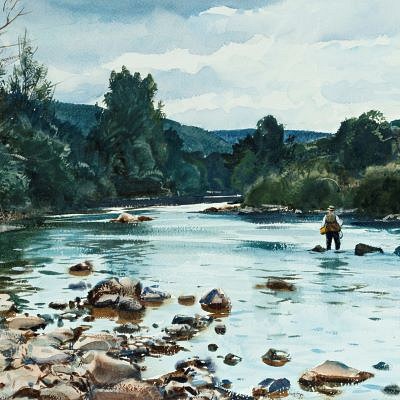Humpback Pintail Drake Decoy, The Ward Brothers
About Seller
20 Winter Street
Pembroke, MA 02359
United States
Founded in 2005, Copley Fine Art Auctions is a boutique auction house specializing in antique decoys and American, sporting, and wildlife paintings. Over the course of the last two decades, the firm has set auction records for not only individual decoy makers, but also entire carving regions. Copley...Read more
Two ways to bid:
- Leave a max absentee bid and the platform will bid on your behalf up to your maximum bid during the live auction.
- Bid live during the auction and your bids will be submitted real-time to the auctioneer.
Bid Increments
| Price | Bid Increment |
|---|---|
| $0 | $50 |
| $1,000 | $100 |
| $2,500 | $250 |
| $5,000 | $500 |
| $10,000 | $1,000 |
| $25,000 | $2,500 |
| $50,000 | $5,000 |
About Auction
Feb 20, 2021
Lots 293-596 Copley Fine Art Auctions cinnie@copleyart.com
- Lot Description
The Ward Brothers
Lemuel T. (1896-1984) and Stephen (1895-1976)
Crisfield, MD, c. 1925
17 1/2 in. long
The Ward brothers were among the very few carvers who derived commercial success from both hunters and collectors during their lifetimes. In the 1920s, they quickly found local notoriety with carvings such as this pintail. By the 1930s, they were shipping birds to Chicago and California. "The famous decoy contest in 1948," writes Quintina Colio on the heritage of decoys, was held in the Grand Central Palace, New York City, sponsored by Schaefer Brewing Company and the winner was the Ward Brothers, from Crisfield, Maryland. Renowned judges included Wm J. Mackey, Jr., Lynn Bogue Hunt and Dr. Edgar Burke. At the Mackey auctions in the 1970s, a related humpback drake was cataloged as one of the top birds in the Mackey Collection, and bidders agreed.
The Ward humpback pintail has been coveted by collectors for decades with the few remaining examples seen in the nation's top museums, collections, and publications.
Ward authorities Gard and McGrath note that the pintail was Lem's favorite bird...This partiality was supported by their early experiences with the species. In Colio's American Decoys, Southern historian, collector, and friend of the Wards William H. Purnell Jr. recounted that in their early days the Wards were avid duck hunters, gunning the Cedar Island Marsh in Somerset County, Maryland. Steve recalls that they would pole out to their duck blind, shoot all day then they would pole back a journey of four miles. He said that when he and Lem would approach the sand bar the pintails and the baldpates would jump up and would resemble a cloud of smoke¦they enjoyed some of the best shooting on the Chesapeake Bay. With these experiences, it is not a surprise that many of the brothers best early carvings were of pintails and wigeon.
A nearly identical rigmate to this lot was chosen as not only the lead image for an impressive chapter on this species in Gard and McGrathâ's book, but also the sole feature of the back dust jacket. Discussing this rigmate from the Gard collection, the authors write, This decoy is the epitome of the Wards' Hump Back design, with the head set back and almost touching the back of the bird. The body is rotund but elongated, with a magnificent accent of an exaggerated upward sweeping tail...This decoy is extremely desirable."
The carving's underside bears an inked inscription "1934 L. T. Ward - Bros." The paint and form more accurately date it to the mid-to-late 1920s. The underside retains three links of chain used for ballast.
Original paint with gunning wear, working repaint to white on front and back and the brown on head. Old worn chip to top of tail, neck seam separation, missing right eye, age line in neck, breast, and bottom.
Provenance: William K. du Pont Collection
Literature: Ronald J. Gard and Brian J. McGrath, "The Ward Brothers' Decoys: A Collector's Guide," Plano, TX, 1989, pp. 57, 61, pl. 51 and back dust-jacket cover, rigmate illustrated and discussed. Loy S. Harrell Jr., "Decoys: North America's One Hundred Greatest," Iola, WI, 2000, p. 9, related drake illustrated. Quintina Colio, "American Decoys," Ephrata, PA, 1972, p. 2, related decoy illustrated. Richard A. Bourne Co., Inc., "Very Rare and Important American Bird Decoys from the Collection of the late William J. Mackey Jr. of Belford, New Jersey," Hyannis, MA, 1974, Sessions V & VI, lot 583, rigmate illustrated. Adele Earnest, "Folk Art in America," Exton, PA, 1984, p. 127, related decoy illustrated. Jeff Waingrow, American Wildfowl Decoys, New York, NY, 1985, frontispiece and p. 29, related decoy from American Folk Museum illustrated.Please email condition report requests to colin@copleyart.com. Any condition statement given is a courtesy to customers, Copley will not be held responsible for any errors or omissions. The absence of a condition statement does not imply that the lot is in perfect condition.Condition
- Shipping Info
-
Copley Fine Art Auctions does not handle the shipping of any items. Shipping is the sole responsibility of the buyer. Once your payment has cleared and we have received your shipping form, items may be released for shipment. Copley Fine Art Auctions, LLC shall have no liability for any loss or damage to such items. Buyers should allow up to four weeks for shipment.
Please be aware that internet bidders may NOT not pick up their items at the sale. Items will be available for pick up by appointment or by shippers five days after the sale.
-
- Buyer's Premium



 EUR
EUR CAD
CAD AUD
AUD GBP
GBP MXN
MXN HKD
HKD CNY
CNY MYR
MYR SEK
SEK SGD
SGD CHF
CHF THB
THB














